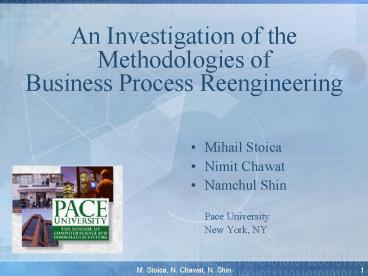An Investigation of the Methodologies of Business Process Reengineering - PowerPoint PPT Presentation
1 / 18
Title:
An Investigation of the Methodologies of Business Process Reengineering
Description:
Chase BPR Methodology. The four phases in most reengineering projects: ENERGIZE. Case for Action ... Blueprint. 20% Plan the. Journey ... – PowerPoint PPT presentation
Number of Views:66
Avg rating:3.0/5.0
Title: An Investigation of the Methodologies of Business Process Reengineering
1
An Investigation of theMethodologies of
Business Process Reengineering
- Mihail Stoica
- Nimit Chawat
- Namchul Shin
- Pace University
- New York, NY
2
Questions
An Investigation of the Methodologies of Business
Process Reengineering
- What is reengineering?
- What to reengineer?
- How to reengineer?
3
What is reengineering?
An Investigation of the Methodologies of Business
Process Reengineering
- Radical change, fast
- A fundamental rethinking and transformation of an
integrated set of business processes - Aims for dramatic business results
- Unlike quick hits and incremental improvement,
reengineering is a form of organizational change - Characterized by dramatic process transformation
4
The term process in the context of reengineering
An Investigation of the Methodologies of Business
Process Reengineering
- A process is a series of related activities that
- takes an input
- adds value to it
- produces an output for a customer
5
What to reengineer?
An Investigation of the Methodologies of Business
Process Reengineering
- BPR changes processes, not functions,
departments, geographies or tasks.
6
How many BPR projects are failing?
An Investigation of the Methodologies of Business
Process Reengineering
- 70 (Murphy 1994, Malhotra 1998)
- 50 (Caron et al. 1994)
7
Why BPR projects are failing?
An Investigation of the Methodologies of Business
Process Reengineering
- Lack of senior management sponsorship
- Failure to make an ongoing commitment to the
tough management decisions needed to effect these
changes to the work environment - Lack of motivation
8
Methodologies issues
An Investigation of the Methodologies of Business
Process Reengineering
- SELECTION Many companies are developing their
own BPR methodologies - TIME The need to test the project empirically so
that it can be validated and modified as
appropriate. In the case of BPR, this poses a
problem since a typical reengineering project can
last 1-2 years - BPR efforts cannot be uniformly applied across
different cultures but need to be tailored to the
specific contingencies of the situation
9
5 methodologies
An Investigation of the Methodologies of Business
Process Reengineering
10
Consolidated Methodology
An Investigation of the Methodologies of Business
Process Reengineering
- A consolidated methodology has been developed
from the five methodologies previously presented
and a model was developed to provide a structured
approach and to facilitate understanding (Muthu,
Whitman and Cheraghi 1999).
11
Gateway BPR Methodology
An Investigation of the Methodologies of Business
Process Reengineering
- A typical methodology developed by Gateway, a BPR
consulting firm, helps illustrate the three
levels of abstraction of Methodologies,
Techniques and Tools (MTTs) for BPR. The Gateway
methodology consists of six stages - 1. Preparation
- 2. Identification
- 3. Vision
- 4. Solution technical design
- 5. Solution social design
- 6. Transformation.
12
BPR Methodology (Evans 1993)
An Investigation of the Methodologies of Business
Process Reengineering
- Evans proposes four general stages as follows
- Stage 1 To BeThis stage is concerned with
defining the vision of where the organisation
wants to be and what it requires of its business
processes as a consequence. - ? Stage 2 As IsConcerned with defining the
current business processes. - ? Stage 3 The PlanThis stage involves making a
plan to accomplish the move from the 'as is'
stage to the 'to be' stage. - ? Stage 4 The CrossingThis stage is concerned
with implementing the plan.
13
BPR Methodology
An Investigation of the Methodologies of Business
Process Reengineering
A Methodology for Business Process Reengineering
(Fitzgerald and Murphy 1996)
14
Chase BPR Methodology
An Investigation of the Methodologies of Business
Process Reengineering
- The four phases in most reengineering projects
15
Future Trends
An Investigation of the Methodologies of Business
Process Reengineering
- Area of supply chain management and logistics.
- Although currently fading, however BPR may
increase in importance again, in some form or
known by some other name the BPR phenomenon
would be of enduring importance.
16
Conclusions
An Investigation of the Methodologies of Business
Process Reengineering
- 50 to 70 of reengineering efforts fail
- A BPR effort is considered a failure just because
it doesnt provide the dramatic results it
promised to deliver
- BPR is providing some vital ingredients
- intense customer focus
- superior process design
- a strong and motivated leadership
- BPR advocates strenuous hard work and instigates
the people involved to not only to change what
they do but targets at altering their basic way
of thinking itself - Follow a methodology or create a new methodology
- Success of BPR may depend on the people
17
Conclusions
An Investigation of the Methodologies of Business
Process Reengineering
companies need a methodology that takes a
holistic view of the organization
- Agent Relationship Morphism Analysis (Valiris and
Glykas 1999) combines - accounting BPR principles (e.g., efficiency,
effectiveness, and cost), - organizational-theoretic concepts (e.g., roles
and accountabilities), and - some powerful systematic business modeling
techniques applied from IS development.
- Highlights the importance of organizational
strategy and its links to business processes
throughout the redesign exercise. - Provides a set of modeling techniques that
supports the modeling of business processes - Takes an individualistic (employee level) and a
holistic (business process level) view - Takes a holistic and systematic approach to BPR.
18
ARMA
An Investigation of the Methodologies of Business
Process Reengineering































